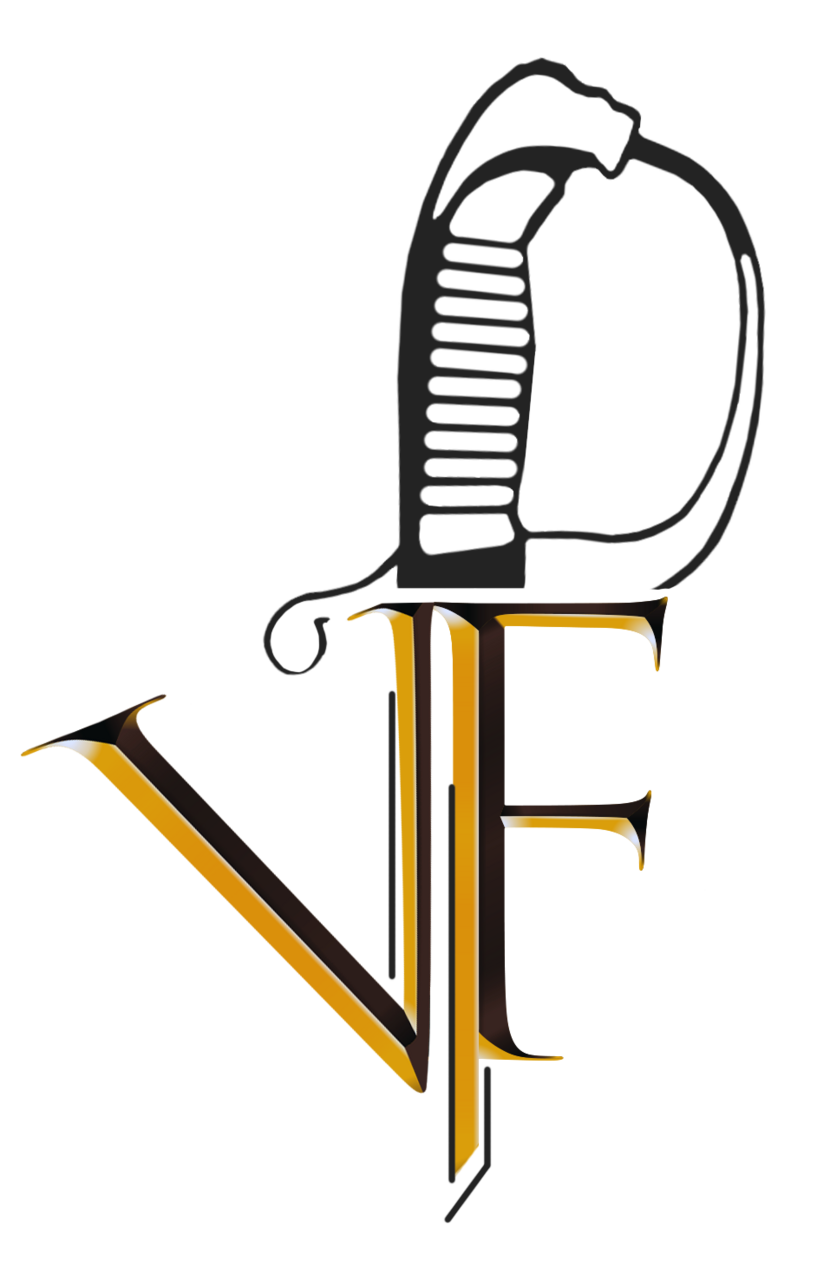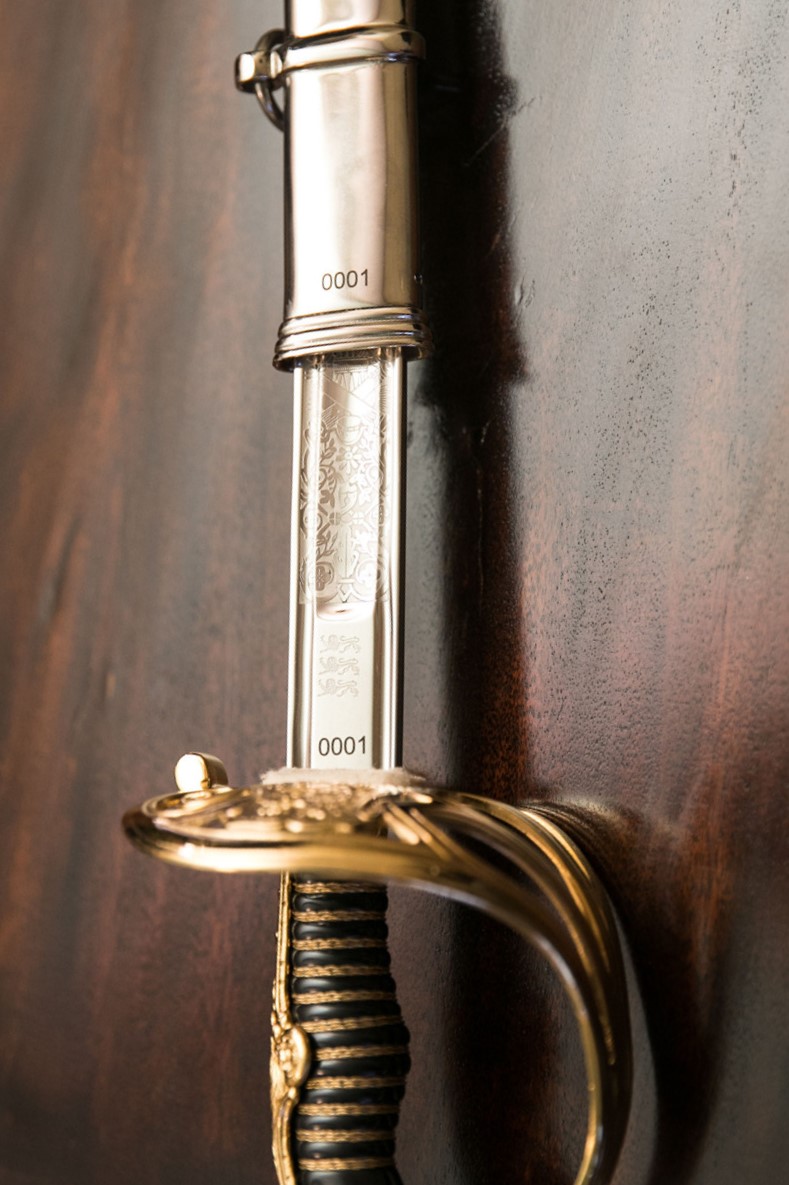CEREMONIAL SWORDS
Swords in the Republic of Estonia before World War II
In the War of Independence, both ceremonial and battle swords were used, which were mostly obtained from the Russian army but also from the departing German soldiers. The sword was carried as a combat weapon by cavalrymen, artillerymen and mounted infantry scouts. At the beginning of the 1920s, the Supply Government of the Defence Forces began to deal more seriously with issues of uniforms, including the sword. In 1921, a first attempted of a uniform regulation was drawn up.
The first samples of the sword were produced in 1924 at the Carl Eickhorn factory in Solingen, Germany. One of the important conditions was that the sword should be decorated with the national emblem - the coat of arms of the Republic. The samples were satisfactory and the search for a manufacturer began, offers came from other factories as well, but in the end the Carl Eickhorn factory was chosen, and an order was placed from which the first batch arrived to Estonia in 1925.
The uniform regulation, which included, in addition to the battle sword, the army's ceremonial sword was approved in 1924, the description of the navy officers' ceremonial sword was approved in 1925. The regulation was supplemented several times, and in 1937, the dagger (kortik) was also introduced as the ceremonial weapon of naval, air force and air defense artillery officers. By 1935, infantry and naval ceremonial swords remained in active use, battle swords began to disappear.
The sword of the Estonian Defense Forces was an element of the officer's uniform, which was worn at ceremonial ceremonies and parades. Swordsmanship was considered one of the basic skills of every officer, and at the military school, sword handling was part of the curriculum for both initial training and senior officer refresher courses.
Illustrations: Description of the uniform of the Defense Forces and regulations on the wearing of uniforms 1939Ceremonial swords in the restored Republic of Estonia
Since its establishment, the Estonian Reserve Officers' Association (EROK) has considered it important to maintain historical continuity and considers itself the successor of the Reserve Officers' Central Section (TOS) founded on 23.06.1933, thereby keeping alive the traditions of the Estonian officer society that developed after the War of Independence. Therefore, it is understandable that EROK saw the need to restore the culture of carrying a sword, which was an important part of being an officer for the pre-war Estonian officers.
As early as at the Independence Parade in 1993, the colour guard of Kuperjanov's Single Infantry Battalion had swords that were borrowed from the museum, but showed that the members of the armed forces have a desire to use swords. At the Victory Day parade in Rakvere in 2004, the navy officers were caring swords. At the Victory Day parade in Paide in 2005, colour guard of reserve officers was added, and in 2006, at the Independence Parade , 4 colour guards were present but still with borrowed swords. This was the last confirmation that the Estonian Defense Forces needs its own swords!
In April 2006, EROK Chairman major (reserve) Heino Piirsalu contacted the Weyersberg, Kirschbaum & Cie (W.K.C.) factory in Solinger, Germany, to begin the restoration of the Army Officer's Ceremonial Sword. By that time Carl Eickhorn's factory no longer produced swords. W.K.C. also has a long history of making swords and follows traditional techniques and technologies - the swords and daggers are made by hand and the traditional acid etching technique is used to decorate the blades. It was also decisive that the factory produces swords for the defense forces of most European countries.
Few of the original Estonian officers' swords introduced in 1925 have survived to this day. In 1940, the swords in the account of the military units were forced to be handed over to the Red Army and the new government. In 1941, the civilian population was also ordered to hand over the cold weapons in their hands (daggers, swords, bayonets).
In order to restore the tradition of ceremonial use of swords in Estonian Defence Forces, the original surviving sword, photographs and documents from collectors, museums and archives were used in the restoration process.
Illustrations: Description of the uniform of the Defense Forces and regulations on the wearing of uniforms 1939
Restored ceremonial swords
In the period between the wars, non-commissioned officers did not have a separate ceremonial sword, but a heavy cavalry and artillery officers battle sword was used in ceremonies if necessary. After the officers' ceremonial swords were restored and they were actively used in parades, a situation arose where non-commissioned officers started using the officers' swords because there was no other option. The situation became particularly difficult when the position of a command sergeant major of the Defense Forces was created, the duties of which included conducting parades and ceremonial formations, and the same task was performed by the command sergeant majors of the units.
As a result of this need, the EROK in cooperation with the non-commissioned officers of the defense forces began to work on the development of the non-commissioned officers' sword, the example was taken from the heavy battle sword used before the war, as well as from the non-commissioned officers' swords in use in other parts of the world, and of course it was considered that the created sword would first of all represent the non-commissioned officers of the Republic of Estonia. By 2019, the sword was ready.
Traditions
In 2010, the Commander of the Defence Forces, lieutenant general Ants Laaneots, handed over the Army Officers Sword donated by the Reserve Officers' Association to the best graduate, second lieutenant Ragnar - Aleksander Jõgus, who graduated with honors from the military school. From that day Defense Forces Academy has adopted the tradition to present to the best graduates from the army, navy and air force course their military branches sword.
Photo: Defense Forces 2018
In 2006, the Estonian Reserve Officers' Association donated Army Officer Sword No. 0001 to the President of the Republic of Estonia and it is held in Kadriorg Presidential Palace. Since 2017 it has become a tradition for the president to hand over the sword to the Independence Day parade Estonian flag committee which always consists of reserve officers. After the parade, the sword must be returned to the president.
Sword numbering
Sword No. 0000 (000 for Navy Office Sword) of each military branch is a reference sword, which remains at the disposal of the Estonian Reserve Officers' Association and is an example in the production of subsequent swords.
Army Officers Swords No. 0001 – 0009 are institutional swords, which have been donated in order to - the President of the Republic of Estonia, the Commander of the Defense Forces, the Commander of the Defense League, the Military School and the Estonian War Museum.
Air Force Dagger No. 0001 is institutional and belongs to the Commander of the Air Force.
Navy Officer Swords No. 001-004 are considered
institutional and were given in order to - highest ranking navy officer at that
time, Commander of the Estonian Navy at that time, the first re-independent Estonian Commander
of the Navy and Defence Leagues Tallinn Unit Naval Division chief at that time.
Army Officer Sword beginning from
No. 0010, Navy Officer Sword from No. 0005 and Air Force Officer Dagger from No. 0002 can be ordered by Estonian officers for their personal use, whereas the Army Officer Sword No. 0010 was given as a gift by the Estonian Reserve Officers' Association to the Knight's Cross cavalier Harald Nugiseks, on his 85th anniversary.
Swords starting from No. K10001 are collection swords which is shown by the letter K that has been added to the six-digit number. They can be ordered by collectors and person who does not have Estonian officer rank.
Estonian Defense Forces ceremonial sword project major supporters through the years
Lt Col Toomas Luman, LCDR Toomas Peek, mjr Andre Lilleleht, cpt Aivar Riisalu, Hansapank, Estonian Defence Forces, Estonian Defence League, Air Force Headquarters, Defence Leage Tallinn Unit Naval Division.









